There’s been a mixed bag of weather during September, the hotter dry days made peering at insects a priority. They are mostly a joy to observe and obliging to photograph. Bees, Butterflies, Hoverflies, Beetles, Moths, Wasps have all been welcome. House flies have been really, really annoying. Beneficial or not Insects are encouraged here, invertebrates form the stuff of life, at the very least they provide food for birds, they pollinate flowers and fruit and without them we’d all be in a lot of trouble. But they are a tricky lot to identify, unlike our visiting birds who by and large are much easier.
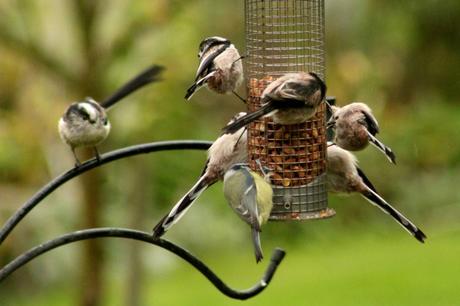
6 Long-tailed Tits are joined by a Blue Tit
To our sheer delight native Long-tailed Tits have made a reappearance in our garden, for most of the year they live on insects, foraged on woodland edges and hedgerows but in the Autumn and Winter we are fortunate to see them on our feeders, adding seeds and nuts to their diet. With a fast undulating flight, which is slightly comical to watch they are always uplifting to see. They are very social birds – parents, offspring and nest helpers all stay together and join in with other birds from the Tit family and can form flocks of 20 or so birds.

Jackdaw
The Jackdaw is a bird that has us jumping up, banging the window or running out of doors clapping our hands loudly, he is ruthless. I think this one is a male as the gray ‘hood’ is quite distinctive and pale. As he swoops in, smaller birds disperse and he will take whole chunks of seed impregnated fat and if allowed he would polish the lot off. Jackdaws are a member of the Crow family and are intelligent scavengers, their diet ranges from insects and seeds to scraps, road kill, eggs and young birds, they are social and usually seen in pairs although we often see just one – carrion birds fulfill a vital part of the food chain otherwise we would be knee deep in decay.
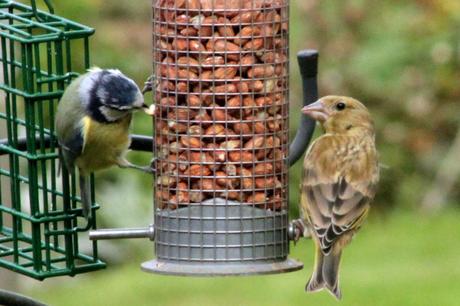
Blue Tit with mottled head feathers on left and larger Female Greenfich on right
We were delighted to see a female Greenfinch back on the feeder and hoped the flashy looking bright green/yellow male would make an appearance too but so far he has been shy. In comparison, she is ‘drab’, with just a little understated yellow on the edges of her wings. They are about the size of a House Sparrow, larger than our Blue Tits and armed with a distinctive beak. Although not rare, they have been in steep decline recently due to the parasite disease trichomonosis, which prevents the Greenfinches from feeding properly.
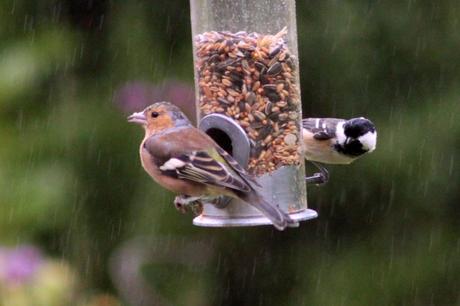
On one of our many rainy days – Left, Male Chaffinch -Right Coal Tit checking out the company
Back to the tricky insects! At first I thought a bumblebee Queen had flown into our garden, I grabbed my camera and took photos from every angle, she was moving very slowly and walked between the Verbena stems, rather than flying on and off. I tried to photograph her markings, hind legs and some facial close ups. On closer inspection I could see the yellow band on her abdomen was broken and was almost giddy with the thought that I was looking at a rare Bumblebee. Turns out though, this is something else.

Southern Cuckoo Bumblebee with ‘broken’ yellow band
I logged on to the Bumblebee Conservation Trust website which the more I use the more I am gaining an understanding and starting to get my ‘eye’ in. After working through the options and eliminating possibilities, I was fairly confident I had photographed a Southern Cuckoo Bumblebee. I submitted a couple of photos for clarification and they confirmed my sighting. She is quite common though in the south of England and is no Queen.
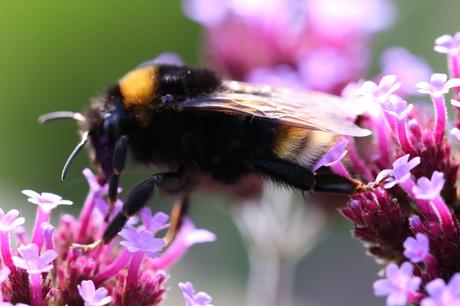
Southern Cuckoo bumblebee walking between flowers with hairy hind legs.
Cuckoo Bumblebees, do not have their own nests in the way true Bumblebees do, instead they sneak into the True Bumbles nests, evict or even kill the true Queen and take over her workers. There are 6 species of Cuckoo Bumblebee and each is designed to attack a specific species of True Bumble. The Southern Cuckoo attacks the nests of the Buff-tailed Bumblebee. I am not certain why these cuckoo bees have evolved this way but the dark evenings of winter are looming and there will be time to learn.
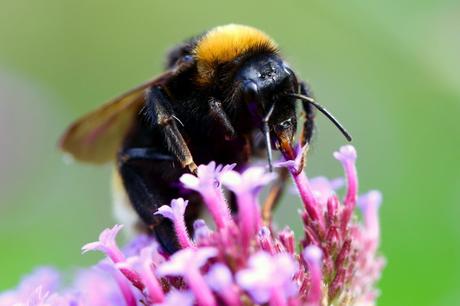
Nectaring Southern Cuckoo bumblebee
As well as the birds there are several other insect predators lurking in our garden and this one lives in my potting shed! The Garden Spider – Araneus diadematus is in the process of parcelling up his lunch. Females are 15mm long and Males 9mm, this one was quite small, so guessing he was a he. If you look closely, he is in the process of preparing what looks like a Butterfly, as the tail extends to the last visible web line. There is a very helpful website the British Arachnological Society to help with lots more spider identifications.
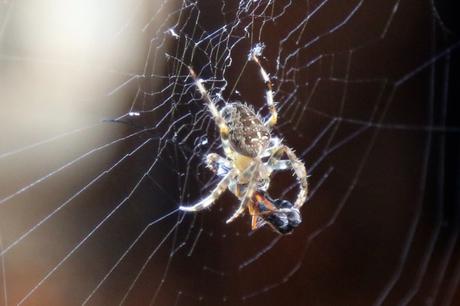
Potting shed companion – Garden Spider eating lunch
During the sunny last week of September a Common Darter Dragonfly came to rest on one the terracotta pots in my pile of ‘stuff to sort out’ Balancing on one leg I leant in to have a close up look. Adult Dragonflies also feed on insects including unwelcome midges. Dragonfly larvae, hatch in ponds and are strong swimmers, they are more voracious and include tadpoles in their diet. The British Dragonfly society has a very helpful website, detailing their amazing lifecycle and helping with identifications.
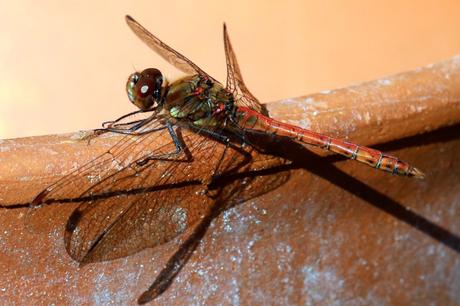
Common Darter Dragonfly
Still balancing on one leg and leaning over my ‘pile of stuff to sort’, I could sense movement to my left. There is a tarpaulin laying over some pieces of wood destined for a future project. And just sitting on top of the tarpaulin was quite a large frog, males are 9cms long and females 13cms, I did not have a tape measure handy but guessed she could be a she. Frogs eat insects, slugs and worms, they are threatened in turn by disease and loss of habitat.
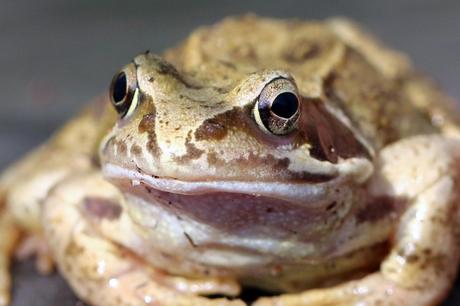
Common Frog
We eye balled each other for a few seconds, as the frog was gulping I pulled back to stand on two legs, the Frog just turned obligingly to one side and waited for a while before slowly hopping off to the undergrowth.
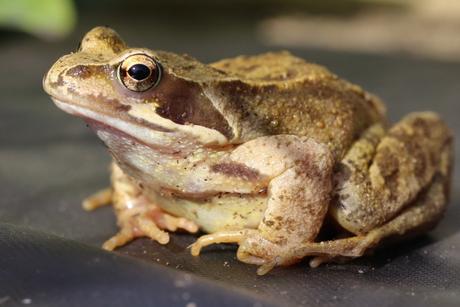
Common Frog
Now this is an easy one for me to identify, in the UK we have only two species of Frog and two species of Toad, I hoped she was well and wondered why she moved so slowly, maybe the heat was slowing her down. In trying to research some more I came across a couple of articles who confirmed kissing a frog will not help in the search for a prince. Who knew! But for a more detailed informative website on amphibians Froglife is definitely worth looking at.
Many thanks to the very lovely Tina from My Gardener Says, who hosts this lovely eye opening, mind broadening meme. Her own post post is packed with visitors and encouragement.
Happy Wildlife Watching!
